Statistical Conceptualisation of Mood Instability: A Systematic Review
Abstract
1. Background/Objectives
2. Methods
2.1. Eligibility Criteria
2.2. Information Sources
2.3. Search Strategy
- Conceptual Terms: “emotion$ instability,” “affect$ instability,” “mood instability,” etc.
- Methodological Terms: “ecological momentary assessment,” “experience sampling,” “mood monitoring,” etc.
- Combined Search: Boolean operators were used to link conceptual and methodological terms (e.g., “mood instability AND ecological momentary assessment”). Full Search Terminology (see Supplementary Materials, Table S1).
2.4. Full Searches
- Exp emotional instability.
- ‘emotion$ instability’ or ‘emotion$ unstable’ or ‘emotion$ labil$’ or ‘emotion$ dysregulat$’ or ‘emotion$ variab$’ or ‘emotion$ fluctuat$’.
- ‘affect$ instability’ or ‘affect$ labil$’ or ‘affect$ dysregulat$’ or ‘affect$ variab$’ or ‘affect$ fluctuat$’.
- ‘Mood instability’ or ‘mood labil$’ or ‘mood dysregulat$’ or ‘mood variab$’ or ‘mood fluctat$’.
- (1 or 2 or 3 or 4).
- Exp ecological momentary assessment.
- ‘experience sampling’ or ‘experience sampling method$’.
- Mood monitoring.
- (6 or 7 or 8).
- (5 AND 9).
2.5. Selection Process
2.6. Data Collection Process
2.7. Data Items
2.8. Study Risk of Bias Assessment/Effect Measures
2.9. Synthesis Methods
3. Results
3.1. Study Characteristics
3.2. Statistical Methods Chosen over Time
3.3. Type of Sample
3.4. Constructs of Mood
4. Discussion
5. Conclusions
Supplementary Materials
Author Contributions
Funding
Acknowledgments
Conflicts of Interest
References
- Jahng, S.; Wood, P.K.; Trull, T.J. Analysis of affective instability in ecological momentary assessment: Indices using successive difference and group comparison via multilevel modeling. Psychol. Methods 2008, 13, 354–375. [Google Scholar] [CrossRef]
- Broome, M.R.; Saunders, K.E.; Harrison, P.J.; Marwaha, S. Mood instability: Significance, definition and measurement. Br. J. Psychiatry 2015, 207, 283–285. [Google Scholar] [CrossRef]
- O’DOnnell, L.A.; Ellis, A.J.; Van de Loo, M.M.; Stange, J.P.; Axelson, D.A.; Kowatch, R.A.; Schneck, C.D.; Miklowitz, D.J. Mood instability as a predictor of clinical and functional outcomes in adolescents with bipolar I and bipolar II disorder. J. Affect. Disord. 2018, 236, 199–206. [Google Scholar] [CrossRef]
- Marwaha, S.; Parsons, N.; Flanagan, S.; Broome, M. The prevalence and clinical associations of mood instability in adults living in England: Results from the Adult Psychiatric Morbidity Survey 2007. Psychiatry Res. 2013, 205, 262–268. [Google Scholar] [CrossRef]
- Miller, J.D.; Pilkonis, P.A.; Mulvey, E.P. Treatment utilization and satisfaction: Examining the contributions of axis II psychopathology and the five-factor model of personality. J. Pers. Disord. 2006, 20, 369–387. [Google Scholar] [CrossRef]
- Yen, S.; Shea, M.T.; Sanislow, C.A.; Grilo, C.M.; Skodol, A.E.; Gunderson, J.G.; McGlashan, T.H.; Zanarini, M.C.; Morey, L.C. Borderline personality disorder criteria associated with prospectively observed suicidal behavior. Am. J. Psychiatry 2004, 161, 1296–1298. [Google Scholar] [CrossRef] [PubMed]
- Marwaha, S.; He, Z.; Broome, M.; Singh, S.P.; Scott, J.; Eyden, J.; Wolke, D. How is affective instability defined and measured? A systematic review. Psychol. Med. 2013, 44, 1793–1808. [Google Scholar] [CrossRef]
- Socada, J.L.; Söderholm, J.J.; Rosenström, T.; Ekelund, J.; Isometsä, E. Presence and Overlap of Bipolar Symptoms and Borderline Features during Major Depressive Episodes. J. Affect. Disord. 2021, 280, 467–477. [Google Scholar] [CrossRef]
- Trull, T.J.; Solhan, M.B.; Tragesser, S.L.; Jahng, S.; Wood, P.K.; Piasecki, T.M.; Watson, D. Affective instability: Measuring a core feature of borderline personality disorder with ecological momentary assessment. J. Abnorm. Psychol. 2008, 117, 647–661. [Google Scholar] [CrossRef]
- Trull, T.J.; Lane, S.P.; Koval, P.; Ebner-Priemer, U.W. Affective Dynamics in Psychopathology. Emot. Rev. J. Int. Soc. Res. Emot. 2015, 7, 355–361. [Google Scholar] [CrossRef]
- Kuppens, P.; Oravecz, Z.; Tuerlinckx, F. Feelings change: Accounting for individual differences in the temporal dynamics of affect. J. Pers. Soc. Psychol. 2010, 99, 1042–1060. [Google Scholar] [CrossRef] [PubMed]
- Kuppens, P.; Tuerlinckx, F.; Russell, J.A.; Barrett, L.F. The relation between valence and arousal in subjective experience. Psychol. Bull. 2013, 139, 917–940. [Google Scholar] [CrossRef]
- Russell, J.A. A circumplex model of affect. J. Personal. Soc. Psychol. 1980, 39, 1161–1178. [Google Scholar] [CrossRef]
- Vansteelandt, K.; Houben, M.; Claes, L.; Berens, A.; Sleuwaegen, E.; Kuppens, P. Self-criticism and dependency predict affective variability in borderline personality disorder: An ecological momentary assessment study. Pers. Disord. Theory Res. Treat. 2020, 11, 270–279. [Google Scholar] [CrossRef]
- Kuppens, P.; Van Mechelen, I.; Nezlek, J.B.; Dossche, D.; Timmermans, T. Individual differences in core affect variability and their relationship to personality and psychological adjustment. Emotion 2007, 7, 262–274. [Google Scholar] [CrossRef]
- Moskowitz, D.S.; Zuroff, D.C. Flux, Pulse, and Spin: Dynamic Additions to the Personality Lexicon. J. Personal. Soc. Psychol. 2004, 86, 880–893. [Google Scholar] [CrossRef]
- Richels, K.A.; Apple, J.S.; Alderson, R.M.; Roberts, W.L. Keeping calm and carrying on: Relating affect spin and pulse to complex skill acquisition and adaptive performance. Front. Psychol. 2020, 11, 377. [Google Scholar] [CrossRef]
- Eid, M.; Diener, E. Intraindividual variability in affect: Reliability, validity, and personality correlates. J. Pers. Soc. Psychol. 1999, 76, 662–676. [Google Scholar] [CrossRef]
- Larsen, R.J.; Diener, E. Affect intensity as an individual difference characteristic: A review. J. Res. Pers. 1987, 21, 1–39. [Google Scholar] [CrossRef]
- Ebner-Priemer, U.W.; Eid, M.; Kleindienst, N.; Stabenow, S.; Trull, T.J. Analytic Strategies for Understanding Affective (In)Stability and Other Dynamic Processes in Psychopathology. J. Abnorm. Psychol. 2009, 118, 195–202. [Google Scholar] [CrossRef]
- Ebner-Priemer, U.W.; Trull, T.J. Ecological momentary assessment of mood disorders and mood dysregulation. Psychol. Assess. 2009, 21, 463–475. [Google Scholar] [CrossRef] [PubMed]
- Sperry, S.H.; Kwapil, T.R. Affective dynamics in bipolar spectrum psychopathology: Modeling inertia, reactivity, variability, and instability in daily life. J. Affect. Disord. 2019, 251, 195–204. [Google Scholar] [CrossRef] [PubMed]
- Faurholt-Jepsen, M.; Geddes, J.R.; Goodwin, G.M.; Bauer, M.; Duffy, A.; Kessing, L.V.; Saunders, K. Reporting guidelines on remotely collected electronic mood data in mood disorder (eMOOD)-recommendations. Transl. Psychiatry 2019, 9, 162. [Google Scholar] [CrossRef]
- Strejilevich, S.A.; Martino, D.J.; Murru, A.; Teitelbaum, J.; Fassi, G.; Marengo, E.; Igoa, A.; Colom, F. Mood instability and functional recovery in bipolar disorders. Acta Psychiatr. Scand. 2013, 128, 194–202. [Google Scholar] [CrossRef]

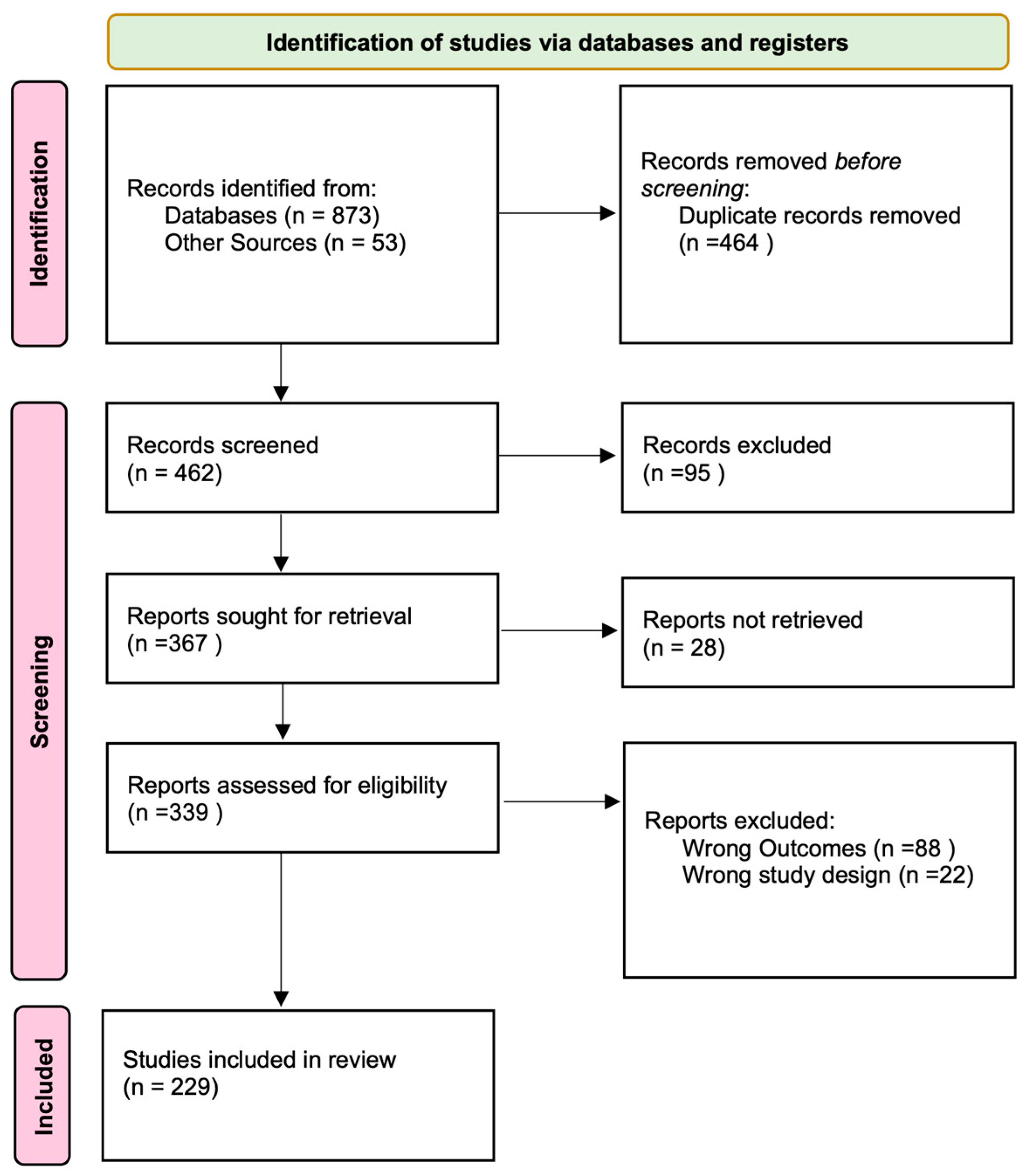
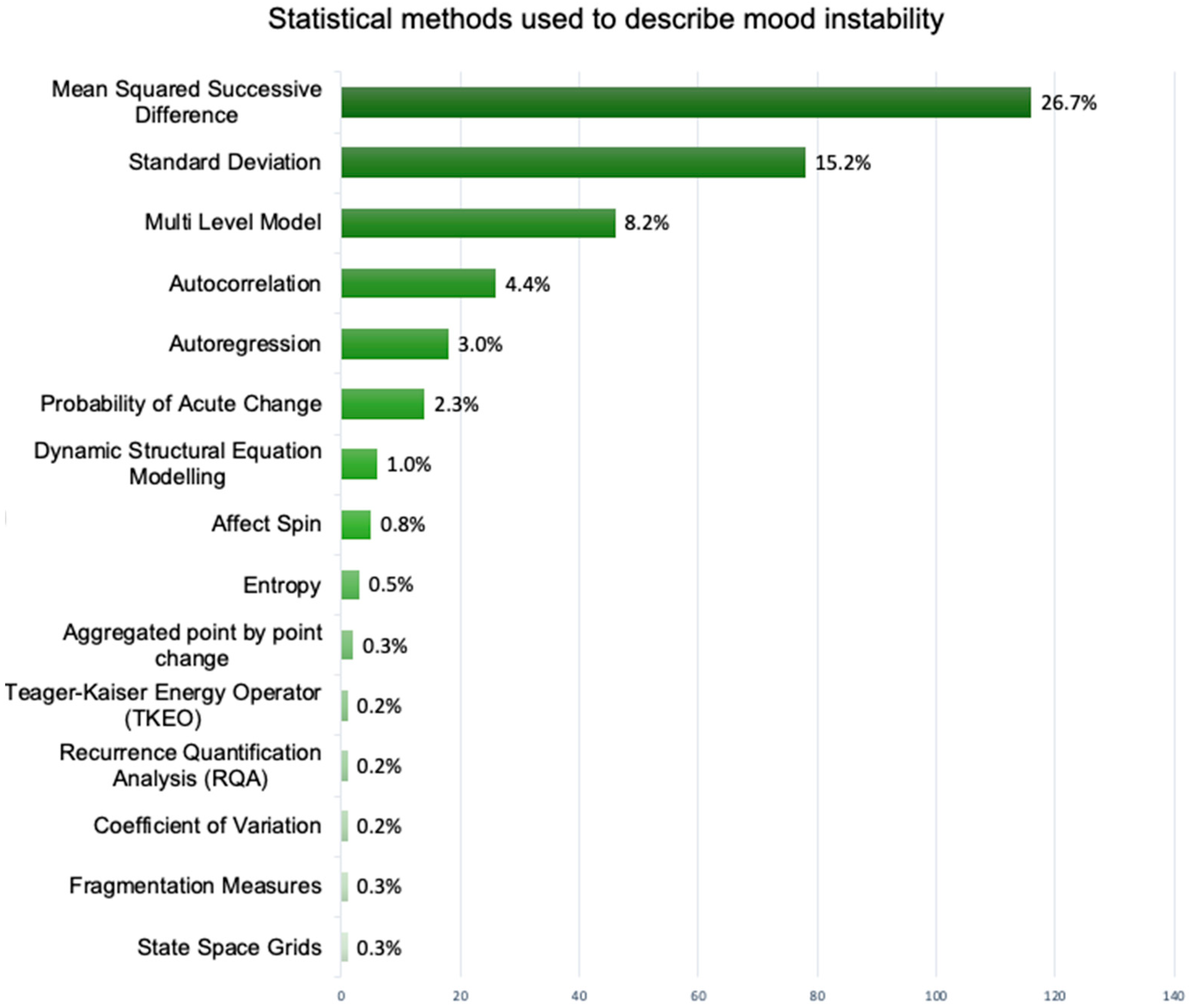
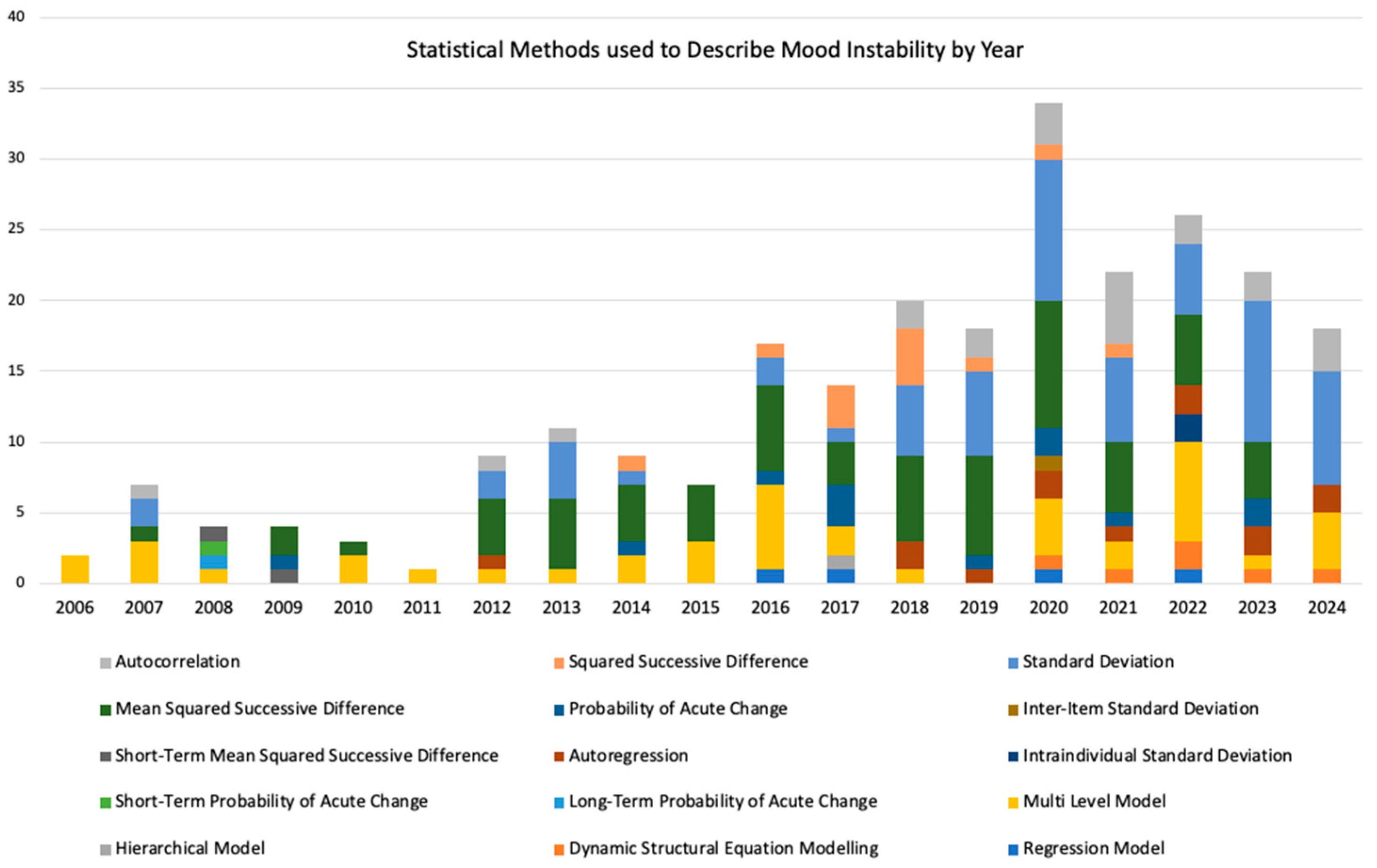
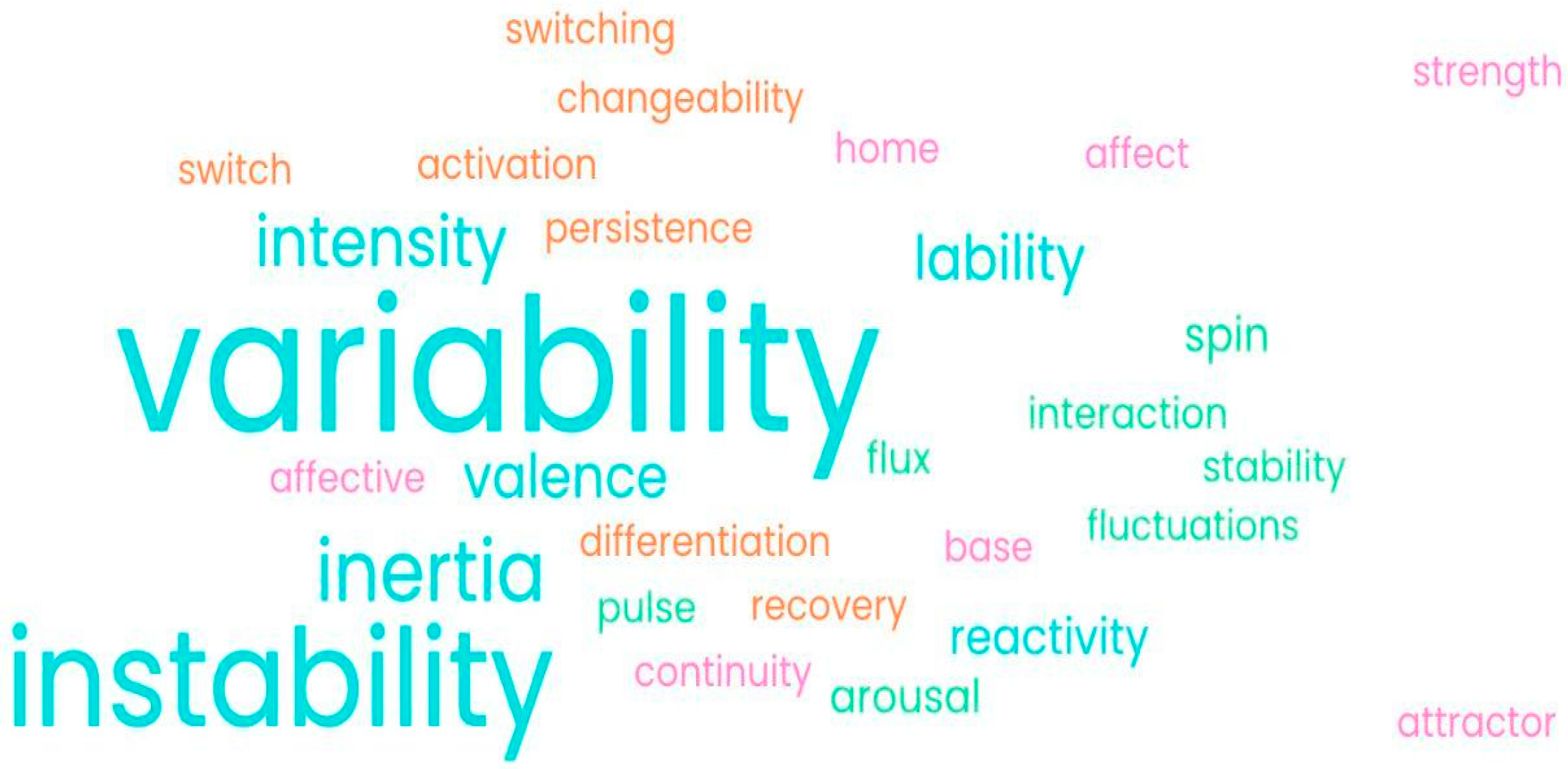
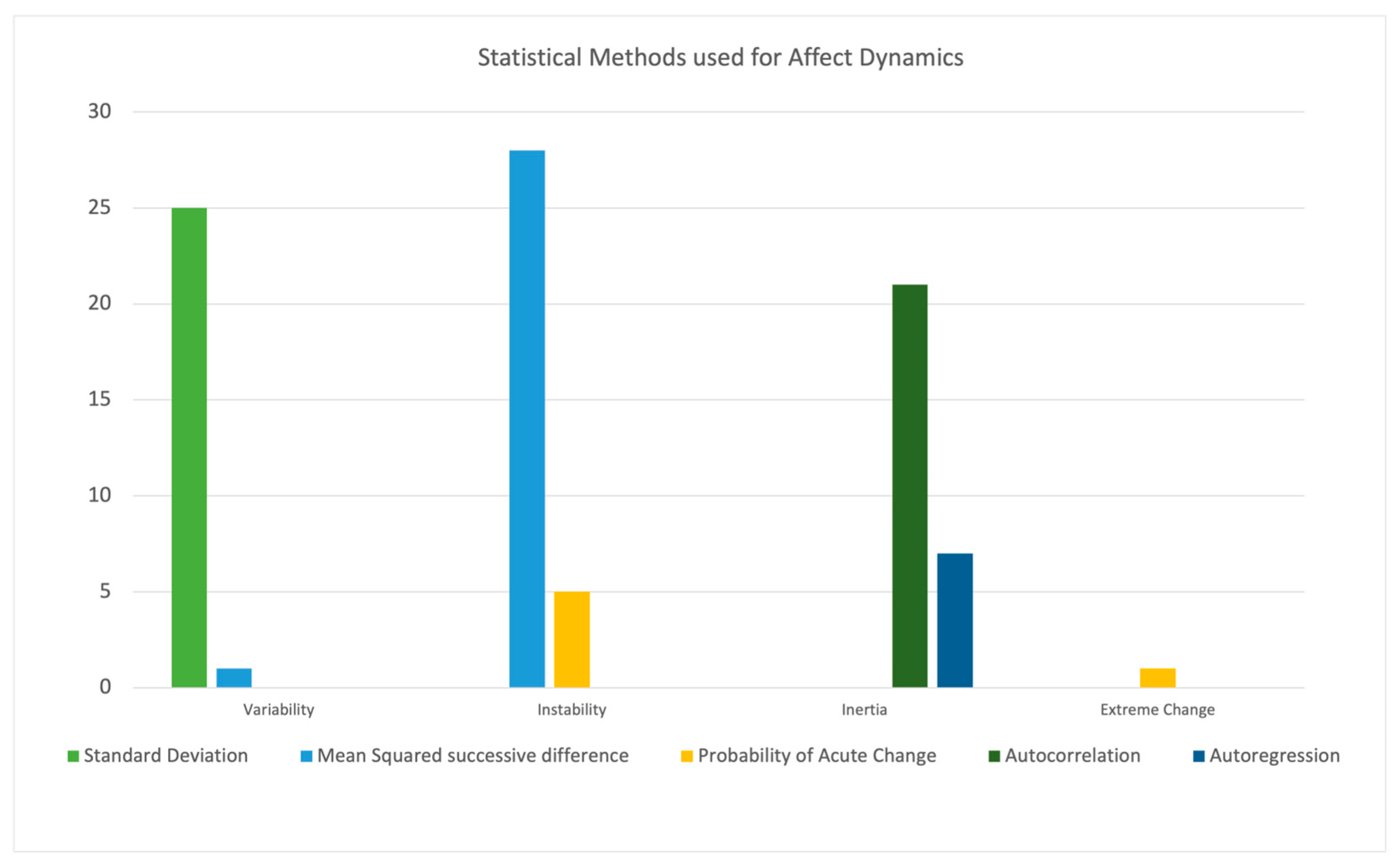
| Mood Construct | Definition | Methods Commonly Used | References |
|---|---|---|---|
| Variability | Overall amplitude of affective changes (i.e., how much affect deviates around its mean level) | Within-Person Standard deviation | [10] |
| Instability | Variability of mood over time | Mean squared successive difference (MSSD) or root mean squared successive difference (RMSSD) | [10] |
| Inertia | Resistance to change; the tendency for affect to persist from one timepoint to the next | Autocorrelation | [11,12] |
| Intensity | Strength of mood/affective state regardless of valence. | Measured via distance from neutrality or baseline | [12] |
| Valence | The quality of an affective experience in terms of how pleasant vs. unpleasant it is | In dimensional models (circumplex), valence is one axis (pleasantness/activation as two axes). | [12,13] |
| Arousal | The degree of physiological or subjective activation/excitement vs. calmness (ranging from feeling quiet to active). | measured by self-report (low to high activation) | [12,13] |
| Flux/Fluctuations | Degree of within-person variation in specific affect dimensions (valence, arousal, or quadrants). | within-person standard deviations (SD) of affect ratings over time; | [12,14] |
| Pulse | Pulse refers to variability in intensity of affective states, regardless of their valence or activation direction. (intensity variability) | within-person standard deviation of the distance of each affect state from neutral (in valence-activation space). So first compute each time-point’s “distance” from neutral, then see how much that varies. | [15,16] |
| Spin | within-person fluctuations in affect pleasantness and activation potential. | Computed via the angular dispersion of core affect trajectories: take each moment’s core affect (valence & activation), compute its angle relative to some origin, then compute variability (SD) of those angles across time (around that person’s mean angle). Higher spin → experiences more qualitatively different emotions over time. | [15,16,17] |
| Reactivity | change in mood in response to events (often modelled as slope/interaction terms in multilevel models | Typically modelled as slope/interaction. Often multilevel regression of affect on stressor. | [10,11] |
| All MSSD | SD | MLM | |
|---|---|---|---|
| Non Clinical | 42 | 46 | 27 |
| Clinical | 47 | 17 | 10 |
| Clinical and Healthy controls | 26 | 13 | 7 |
| Only One Method | More than One Method | |
|---|---|---|
| clinical | 48 | 26 |
| Non clinical | 78 | 33 |
| Clinical vs. non clinical | 26 | 16 |
Disclaimer/Publisher’s Note: The statements, opinions and data contained in all publications are solely those of the individual author(s) and contributor(s) and not of MDPI and/or the editor(s). MDPI and/or the editor(s) disclaim responsibility for any injury to people or property resulting from any ideas, methods, instructions or products referred to in the content. |
© 2025 by the authors. Licensee MDPI, Basel, Switzerland. This article is an open access article distributed under the terms and conditions of the Creative Commons Attribution (CC BY) license (https://creativecommons.org/licenses/by/4.0/).
Share and Cite
Cairns, I.; Wright, K.; Taylor, G.; Mehen, B.; Anning, R. Statistical Conceptualisation of Mood Instability: A Systematic Review. Brain Sci. 2025, 15, 1059. https://doi.org/10.3390/brainsci15101059
Cairns I, Wright K, Taylor G, Mehen B, Anning R. Statistical Conceptualisation of Mood Instability: A Systematic Review. Brain Sciences. 2025; 15(10):1059. https://doi.org/10.3390/brainsci15101059
Chicago/Turabian StyleCairns, Iona, Kim Wright, Gordon Taylor, Bryher Mehen, and Ruth Anning. 2025. "Statistical Conceptualisation of Mood Instability: A Systematic Review" Brain Sciences 15, no. 10: 1059. https://doi.org/10.3390/brainsci15101059
APA StyleCairns, I., Wright, K., Taylor, G., Mehen, B., & Anning, R. (2025). Statistical Conceptualisation of Mood Instability: A Systematic Review. Brain Sciences, 15(10), 1059. https://doi.org/10.3390/brainsci15101059






